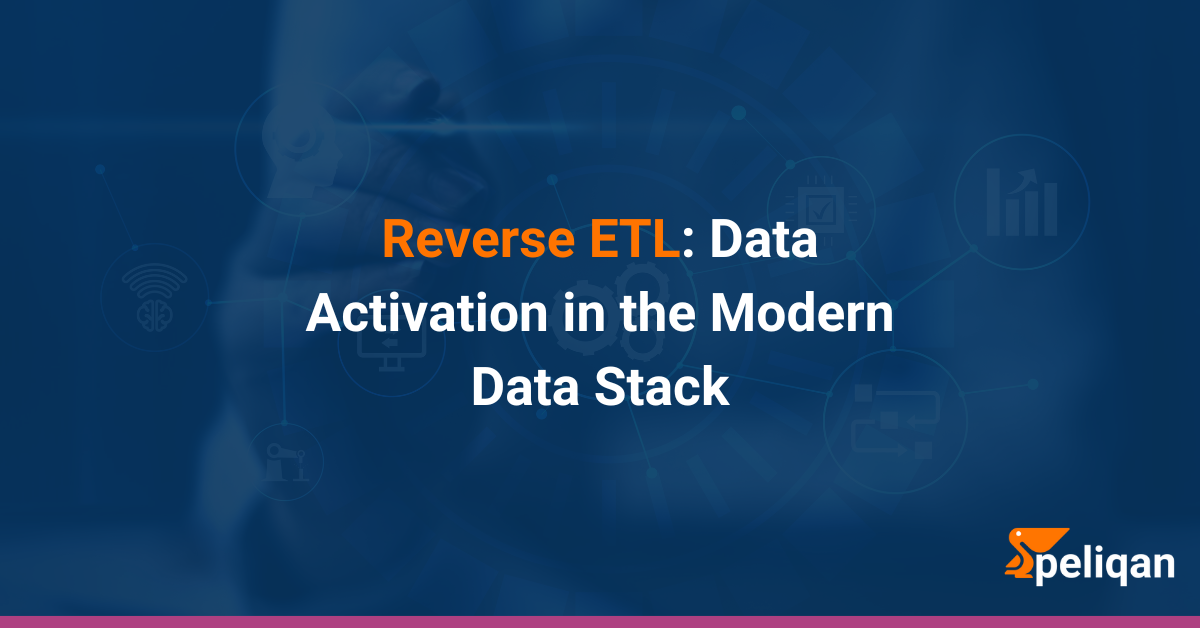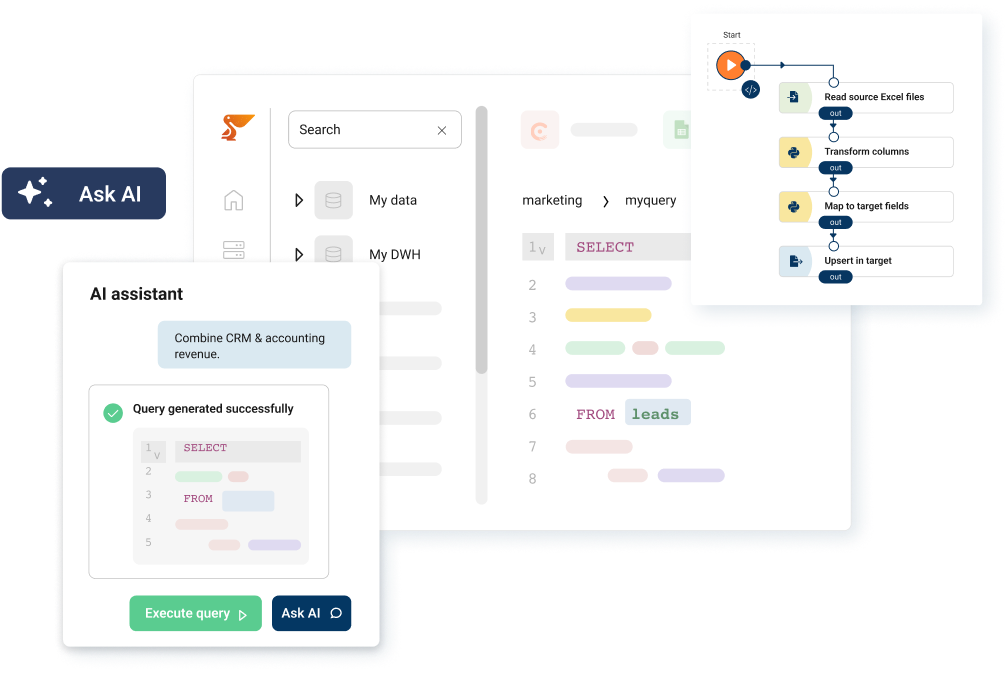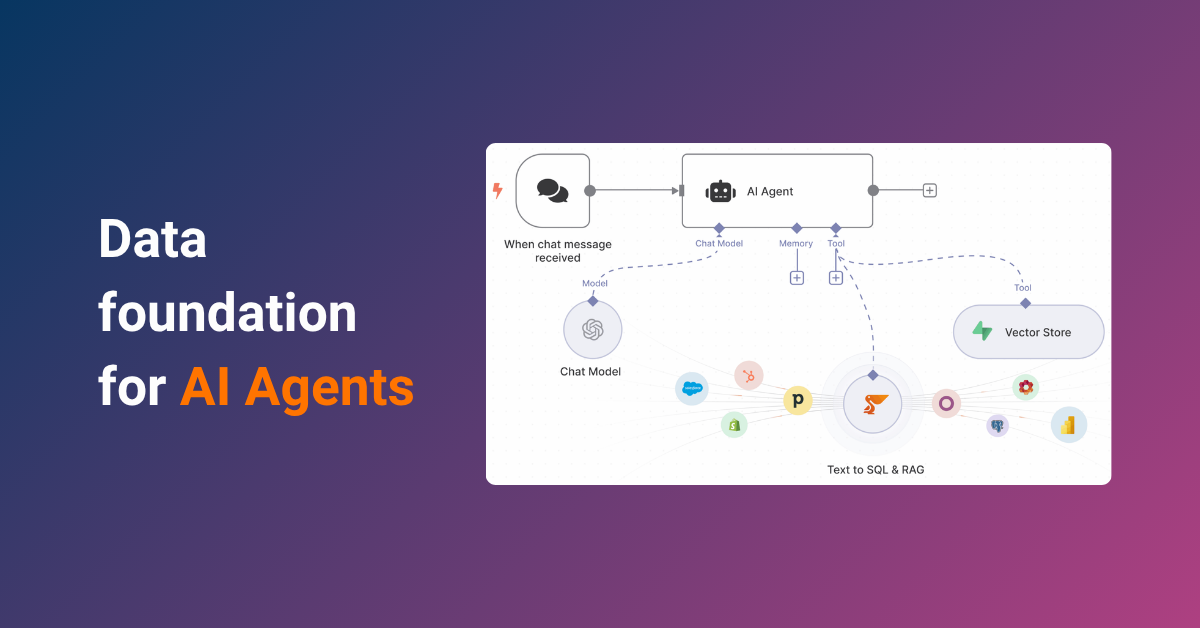In today’s data-driven business landscape, organizations are constantly seeking ways to leverage their data for competitive advantage. While traditional ETL (Extract, Transform, Load) processes have long been the backbone of data warehousing, a new player has emerged on the scene: Reverse ETL.
In the world of data management, a new approach is changing the game. It’s called Reverse ETL, and it’s revolutionizing how businesses use their data. But what exactly is Reverse ETL, and why should you care?
Imagine you have a valuable information locked away in your data warehouse. You’ve spent time and resources collecting, cleaning, and organizing this data. Now, wouldn’t it be great if you could easily put this refined data to work across your entire organization? That’s where Reverse ETL comes in.
Reverse ETL is like a bridge that connects your data warehouse to the tools and applications your teams use every day. It takes the insights hidden in your data warehouse and delivers them right to the fingertips of your sales, marketing, and customer support teams. This means everyone in your company can make smarter, data-driven decisions without needing to be a data expert.
In this comprehensive guide, we’ll explore what Reverse ETL is, why it’s becoming a crucial part of modern data strategy, and how it can benefit your business. Whether you’re a data professional looking to optimize your processes or a business leader aiming to harness the full power of your data, this article will provide you with the knowledge you need to understand and leverage Reverse ETL.
What is Reverse ETL?
Reverse ETL, short for Reverse Extract, Transform, Load, is a process that flips the traditional ETL paradigm on its head. Unlike conventional ETL, which moves data from operational systems to data warehouses, Reverse ETL extracts enriched data from data warehouses and reintroduces it to operational systems. This enables businesses to leverage their refined, analyzed data in real-time decision-making processes and create personalized customer experiences.
The key difference lies in the direction of data flow:
- Traditional ETL: Operational Systems → Data Warehouse
- Reverse ETL: Data Warehouse → Operational Systems
By bridging the gap between data analysis and operational execution, Reverse ETL empowers businesses to move beyond mere insights and into a realm of informed action, ultimately driving improved customer experiences and competitive advantage.
The Evolution of Data Integration: From ETL to ELT to Reverse ETL
To understand the significance of Reverse ETL, it’s essential to trace the evolution of data integration:
- ETL (Extract, Transform, Load): The traditional approach where data is extracted from source systems, transformed, and then loaded into a data warehouse.
- ELT (Extract, Load, Transform): A more modern approach that leverages the power of cloud data warehouses to perform transformations after loading, allowing for greater flexibility and scalability.
- Reverse ETL: The latest evolution, which takes the refined data from the warehouse and pushes it back into operational systems for immediate use.
This progression reflects the changing needs of businesses to not only store and analyze data but also to activate it across their entire organization.
Why is Reverse ETL Important?
Reverse ETL has emerged as a critical tool in the modern data stack for several reasons:
- Democratizing data: It makes data insights readily available to business users across the organization, not just data analysts or IT professionals.
- Enabling data-driven decision making: By pushing enriched data back into operational systems, departments can make decisions based on the latest, most accurate information.
- Personalizing customer experiences: With access to enriched customer data, businesses can deliver hyper-personalized experiences across the entire customer journey.
- Improving operational efficiency: Reverse ETL streamlines data workflows by eliminating data silos and redundancies.
- Simplifying data management: By establishing a single source of truth, it ensures that all teams are working with the most up-to-date information.
- Accelerating time to value: Businesses can drive faster ROI on their data investments by quickly activating data insights within operational systems.
Who Needs Reverse ETL?
Reverse ETL provides significant benefits across various organizational functions, enhancing data-driven decision-making and operational efficiency.
Reverse ETL Use Cases for different teams:
- Data Teams
Data engineers and analysts can operationalize their insights, ensuring that valuable data reaches operational systems in a timely manner. This enables real-time data utilization across the organization.
- Marketing Teams
By accessing enriched customer data, marketers can implement more sophisticated segmentation strategies and create highly targeted, personalized campaigns. This data-driven approach can significantly improve campaign performance. Example: Personalizing email marketing content and offers based on individual customer profiles and engagement history.
- Sales Teams
Sales representatives can leverage up-to-date customer insights to inform their strategies. Access to comprehensive customer data allows for more informed discussions, potentially increasing conversion rates and customer satisfaction. Example: Equipping sales representatives with customer segmentations, purchase histories, and churn risk scores to prioritize leads and personalize interactions.
- Customer Support Teams
With a comprehensive view of customer interactions and history, support agents can provide more contextualized and efficient service. This holistic approach can lead to improved resolution times and enhanced customer experience. Example: Empowering support agents with a 360-degree view of the customer, including past interactions, product usage, and preferences.
- Product Teams
Product managers can utilize aggregated user data to inform product development decisions. This data-centric approach allows for more targeted feature development and iterative improvements based on actual user behavior and preferences. Example: Using aggregated customer feedback and usage data to inform product roadmaps and prioritize feature development.
- Executive Leadership
C-suite executives can access real-time business metrics, enabling more agile and informed strategic decision-making. This timely access to key performance indicators can enhance overall business strategy and execution.
How Does Reverse ETL Work?
Reverse ETL serves as a crucial tool for organizations seeking to maximize the value of their data assets. By facilitating the flow of insights from data warehouses to operational systems, it enables a more responsive, data-driven organizational culture across multiple departments and hierarchical levels. Here’s a breakdown of the key steps involved:
Steps involved in Reverse ETL process
1. Data Extraction: The process begins by identifying and extracting relevant data from your data warehouse. This data has already been cleansed, transformed, and enriched through the traditional ETL process.
2. Transformation: While the data is already refined, it might need some additional transformation to fit the specific needs of the target operational systems. This could involve things like aggregations, calculations, or formatting changes to ensure the data is presented in a way that’s easily consumable by the destination system.
3. Loading: Once the data is transformed, it’s loaded into the designated operational systems. These systems can include various applications across your organization, such as CRM platforms, marketing automation tools, or customer support software.
4. Scheduling and Automation: Reverse ETL processes are typically automated and set to run at regular intervals. This ensures that operational systems always have access to the most up-to-date data, enabling them to function with the latest insights.
By automating these steps, Reverse ETL ensures a continuous flow of enriched data from the data warehouse to operational systems, keeping everyone across the organization working with the freshest information.
Reverse ETL vs. Other Technologies
It’s important to understand how Reverse ETL differs from other data technologies:
Reverse ETL vs. Data Sync
Both Reverse ETL and data synchronization involve moving data between systems. However, their goals differ. Data sync focuses on simply replicating data from one system to another, ensuring consistency. Reverse ETL, on the other hand, is about activating enriched data for specific use cases. It extracts specific data, transforms it as needed, and then pushes it to operational systems to be used for actions and decision-making.
Reverse ETL vs. Customer Data Platforms (CDPs)
Customer Data Platforms (CDPs) are designed to centralize and unify customer data from various sources. They create a single customer profile, providing a holistic view of customer interactions. While CDPs can be powerful tools, Reverse ETL offers more flexibility. It can handle various data types, not just customer data, and activate that data across different business functions, not just marketing.
Reverse ETL vs. API Integrations
Application Programming Interfaces (APIs) enable data exchange between systems. They provide a way for different software applications to communicate and share information. However, API integrations typically focus on basic data exchange. Reverse ETL offers more robust transformation capabilities. It can manipulate and refine data to a much greater degree before loading it into operational systems, ensuring the data is in the exact format and structure needed for specific use cases.
Factors to Consider Before Implementing Reverse ETL
When evaluating the implementation of reverse ETL within your organization, it’s crucial to assess various elements that could influence the effectiveness and productivity of the implementation. Here are several important factors to take into account before Reverse ETL implementation:
Data Quality
The effectiveness of Reverse ETL hinges on the quality of data residing in your data warehouse. Inaccurate or inconsistent data will lead to poor results in your operational systems. Ensure your data is clean, accurate, and well-structured before embarking on Reverse ETL.
Use Case Prioritization
Identify the most impactful use cases for your business and prioritize them for initial implementation. This will help you focus your resources and demonstrate the value of Reverse ETL early on.
System Compatibility
Assess the compatibility of your data warehouse and various operational systems with potential Reverse ETL tools. Not all systems integrate seamlessly, and some may require custom development work.
Data Governance
Implementing Reverse ETL necessitates clear data governance policies. These policies should dictate how data is accessed, used, and updated across different systems within your organization. This ensures everyone is working with the same information and helps maintain data integrity.
Resource Allocation
Consider the personnel and financial resources required for Reverse ETL implementation and ongoing management. You’ll need personnel with the technical expertise to set up, maintain, and monitor the Reverse ETL processes.
Security
When implementing reverse ETL, it’s essential to prioritize security measures. Verify that the chosen solution adheres to strict Service Level Agreements (SLAs) and incorporates uptime monitoring. Ensure there’s a well-defined process for regular updates and security patches. The tool should comply with relevant data protection regulations, such as GDPR, NIS2.
Furthermore, assess the solution’s data security features, including its capability for data tokenization and the encryption standards used for data-at-rest. It’s also crucial to confirm that the tool holds key industry certifications, such as SOC 2 Type 2 and EU/US Privacy Shield.
Benefits of Implementing Reverse ETL
Implementing Reverse ETL can bring numerous benefits to organizations:
- Enhanced Customer Experience: By providing frontline teams with rich, up-to-date customer data, businesses can deliver more personalized and relevant interactions across all touchpoints.
- Improved Operational Efficiency: Reverse ETL eliminates the need for manual data exports and imports, streamlining workflows and reducing the risk of errors.
- Data-Driven Culture: By making data insights readily available to all teams, Reverse ETL fosters a data-driven culture throughout the organization.
- Faster Time-to-Insight: With enriched data flowing directly into operational systems, teams can act on insights more quickly, leading to faster decision-making and improved agility.
- Better Resource Allocation: By providing teams with accurate, real-time data, organizations can optimize resource allocation and focus efforts where they’ll have the most impact.
- Increased ROI on Data Investments: Reverse ETL helps organizations extract more value from their existing data infrastructure by putting warehouse insights to work in day-to-day operations.
5 Best Reverse ETL Tools
Selecting the appropriate Reverse ETL tool is crucial for maximizing its impact on your organization. Here are some top 5 reverse tools to consider:
1. Peliqan.io
Peliqan.io offers a comprehensive suite of data integration and activation tools. It stands out for its user-friendly interface, robust automation capabilities, and extensive list of 100+ pre-built connectors. Peliqan excels in handling complex data transformations and offers advanced features like real-time data syncing and custom workflow creation. Its scalability makes it suitable for businesses of all sizes, from startups to large enterprises. Peliqan also prioritizes data security, offering end-to-end encryption and compliance with major data protection regulations.
2. Hevo Data
This cloud-based ETL/Reverse ETL platform is known for its ease of use and pre-built connectors for popular SaaS applications. Hevo Data supports real-time data replication and provides features like automatic schema mapping and data transformation. Hevo Data is particularly well-suited for small to medium-sized businesses looking for a straightforward, efficient Reverse ETL solution.
3. Fivetran
Fivetran offers a wide range of pre-built connectors and supports both batch and real-time data syncing. Fivetran’s strength lies in its ability to automatically adapt to schema changes, reducing the need for manual intervention. It’s an excellent choice for organizations with complex data ecosystems and a need for high-volume data processing.
4. Stitch
Stitchdata offers a simple, intuitive interface for setting up data pipelines and provides detailed documentation to guide users through the process. While it may not offer as many advanced features as some other tools, its simplicity and reliability make it a solid choice for small to medium-sized businesses.
5. Integrate.io
Integrate.io offers a wide range of integrations and advanced data manipulation capabilities. It provides a visual, low-code interface for building data pipelines and supports both ETL and Reverse ETL processes. Integrate.io stands out for its ability to handle large volumes of data and its robust security features, including field-level encryption.
When choosing a Reverse ETL tool, consider the following factors:
- Data Volume and Complexity: Ensure the tool can handle your data volume and complexity efficiently.
- Integration Needs: Look for tools that offer seamless integration with your existing data sources and applications.
- Budget and User Expertise: Choose a tool that fits your budget and aligns with your team’s technical skills.
- Security and Compliance: Prioritize tools with robust security features and relevant compliance certifications.
- Scalability: Consider your future needs and choose a tool that can grow with your organization.
- Support and Documentation: Evaluate the level of customer support and available documentation to ensure smooth implementation and ongoing use.
Best Practices for Implementing Reverse ETL
To ensure a successful Reverse ETL implementation, consider the following 12 best practices:
1. Start with a Clear Strategy
Before diving into implementation, define your goals and use cases for Reverse ETL. Identify the specific business problems you’re trying to solve and the key performance indicators (KPIs) you’ll use to measure success. This strategic approach will guide your implementation and help you prioritize efforts.
2. Prioritize Data Quality
The effectiveness of your Reverse ETL process depends heavily on the quality of data in your warehouse. Invest time and resources in data cleaning, validation, and governance. Implement data quality checks at various stages of your data pipeline to catch and correct issues early. Consider using data quality tools to automate these processes and maintain high standards of data integrity.
3. Implement Gradually
Rather than attempting a full-scale implementation across your organization, start with a pilot project or a single use case. This approach allows you to test your Reverse ETL setup, identify potential issues, and refine your processes before scaling. Choose a high-impact, low-risk use case for your initial implementation to demonstrate value quickly.
4. Monitor and Optimize
Regularly review your Reverse ETL processes to identify bottlenecks and opportunities for optimization. Set up monitoring and alerting systems to track the performance of your data pipelines, including metrics like data freshness, sync frequency, and error rates. Use this information to continuously improve your Reverse ETL setup, optimizing for speed, reliability, and resource efficiency.
5. Provide Training and Support
Ensure that teams across your organization understand how to use and interpret the enriched data provided through Reverse ETL. Develop comprehensive training materials and conduct workshops to educate users on the new data flows and how to leverage them in their daily work. Establish a support system to address questions and issues as they arise, helping to drive adoption and maximize the value of your Reverse ETL implementation.
6. Maintain Data Privacy and Security
Implement robust security measures and adhere to data privacy regulations throughout the Reverse ETL process. This includes encrypting data in transit and at rest, implementing strong access controls, and maintaining detailed audit logs. Regularly review and update your security practices to address evolving threats and comply with changing regulations.
7. Foster Cross-Functional Collaboration
Encourage collaboration between data teams and business users to maximize the value of Reverse ETL insights. Create forums for regular communication between these groups to identify new use cases, address challenges, and share successes. This collaborative approach ensures that your Reverse ETL implementation remains aligned with business needs and continues to deliver value over time.
8. Document Your Processes
Maintain comprehensive documentation of your Reverse ETL setup, including data sources, transformations, and destination systems. This documentation is crucial for troubleshooting, onboarding new team members, and ensuring the long-term sustainability of your Reverse ETL processes. Regularly update this documentation to reflect changes in your data architecture and Reverse ETL workflows.
9. Plan for Scalability
As your organization grows and your data needs evolve, your Reverse ETL implementation should be able to scale accordingly. Choose tools and design processes that can handle increasing data volumes and complexity. Regularly assess your infrastructure and processes to ensure they can meet future needs, and be prepared to upgrade or switch tools if necessary.
10. Embrace Automation
Look for opportunities to automate various aspects of your Reverse ETL processes, from data validation to pipeline management. Automation can help reduce errors, improve efficiency, and free up your team to focus on higher-value tasks. Consider using workflow orchestration tools to automate complex, multi-step Reverse ETL processes.
11. Implement Version Control
Use version control systems to track changes to your Reverse ETL configurations, scripts, and workflows. This practice allows you to roll back changes if issues arise and provides a clear history of how your Reverse ETL setup has evolved over time. It’s particularly important when multiple team members are working on the same Reverse ETL processes.
12. Conduct Regular Audits
Perform periodic audits of your Reverse ETL processes to ensure they continue to meet business needs and comply with relevant regulations. These audits should cover aspects like data accuracy, process efficiency, security measures, and alignment with business objectives. Use the findings from these audits to drive continuous improvement in your Reverse ETL implementation.
By following these best practices, you can ensure a robust, efficient, and value-driven Reverse ETL implementation that drives data activation across your organization. Remember that implementing Reverse ETL is an ongoing process of refinement and optimization, so remain flexible and responsive to changing needs and emerging opportunities.
The Future of Reverse ETL
As businesses continue to recognize the value of activating their data warehouse insights, Reverse ETL is poised for significant growth and evolution. Some trends to watch in the Reverse ETL space include:
- Increased Automation: AI and machine learning will play a larger role in automating Reverse ETL processes, from data selection to transformation and loading.
- Real-Time Activation: As technology advances, we can expect to see more real-time Reverse ETL capabilities, enabling instant activation of data insights.
- Enhanced Personalization: Reverse ETL will drive even more sophisticated personalization efforts, leveraging advanced analytics and AI to create hyper-targeted experiences.
- Integration with CDPs: Customer Data Platforms (CDPs) will increasingly incorporate Reverse ETL capabilities, creating more comprehensive data activation solutions.
- Expanded Use Cases: As adoption grows, we’ll see Reverse ETL applied to new and innovative use cases across various industries and business functions.
Conclusion: Embracing the Reverse ETL Revolution
Reverse ETL represents a fundamental shift in how organizations leverage their data assets. By bridging the gap between data warehouses and operational systems, it empowers businesses to turn insights into action, driving improved customer experiences, operational efficiency, and competitive advantage.
As you consider implementing Reverse ETL in your organization, remember that success lies not just in the technology itself, but in how you use it to drive meaningful business outcomes. Start by identifying your key use cases, choose the right tools for your needs, and focus on creating a data-driven culture that embraces the power of activated insights.
The future of business is data-driven, and Reverse ETL is a crucial tool in realizing that future. By embracing this technology and the practices that support it, you can unlock the full potential of your data and propel your organization to new heights of success in the digital age.





